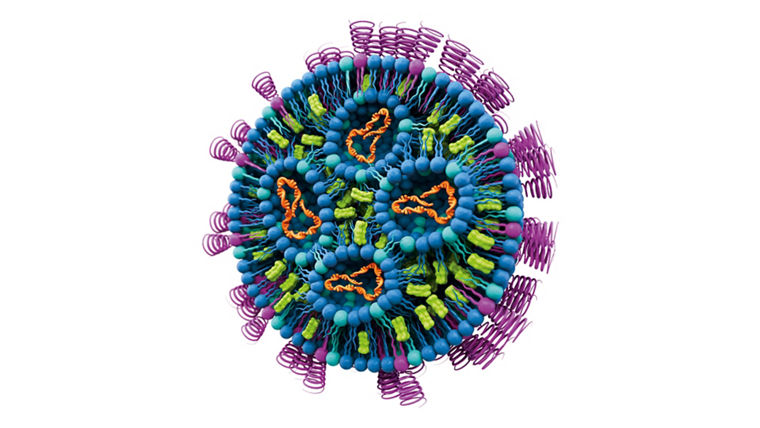Two years ago, who could have imagined that people waiting in line at the supermarket might talk about mRNA vaccines? Or that neighbors would compare vaccine side effects over the garden fence? There is no doubt that the world has changed since the pandemic began, but for all the sacrifices and suffering, one technological breakthrough has emerged victorious. Messenger RNA—or mRNA—has sprung to the forefront of medicine thanks to COVID-19 and is now on the path to transform the prevention and treatment of disease.
Alongside water and fat, our body is mostly made up of proteins—the large, complex molecules that are crucial for the structure, function, and regulation of tissues and organs. mRNA serves as an instruction manual for making proteins, which means it is particularly suitable for use in vaccines. An mRNA vaccine produces an immune response in the body by inducing cells to build a protein that would normally be made by a pathogen, like a virus or cancer cell. “The concept of mRNA technology is simple in a very positive way because it allows the body to turn itself into its own drug factory,” explains Stefan Randl, who is the head of research, development, and innovation at Evonik’s Health Care business line.
COVID-19 has demonstrated a key advantage of this approach: speed. mRNA vaccines can be constructed quickly using only the pathogen’s genetic code. “It takes roughly a week to generate an experimental batch of mRNA vaccine,” explains Randl. “Producing and scaling up is also relatively simple because the technology requires a standard production platform.” High efficacy—strong therapeutic benefits—can also give mRNA vaccines an edge over others. Another positive aspect is that mRNA does not enter the nucleus of a cell, meaning that there is no risk of it being integrated into the chromosomal DNA and therefore no possibility of creating mutations in the genome.

Perhaps one of the biggest advantages of the technology is the potential to use it to tackle other diseases. BioNTech, the German biotech company that together with the American pharmaceutical corporation Pfizer introduced the first mRNA-based vaccination against COVID-19, recently announced that a cocktail of mRNAs suppressed tumors in mouse models of colon cancer and melanoma. “Our vision is to harness the power of the body’s own defense mechanisms against cancer and infectious diseases,” says Özlem Türeci, the co-founder and Chief Medical Officer at BioNTech. In addition to cancer immunology, scientists around the world are currently working on mRNA therapies for influenza, malaria, Zika, and rabies, as well as autoimmune diseases like multiple sclerosis and genetic diseases like cystic fibrosis.
THE DELIVERY PROBLEM
Yet, delivering mRNA effectively and safely into cells to create the desired therapeutic effect is no trivial matter, and is one of the biggest challenges for expanding the use of mRNA therapeutics to promising fields such as cancer immunotherapy, protein replacement or gene editing. Most pharmaceuticals are made up of small molecules which are more likely to be absorbed and can usually be taken orally. In contrast, mRNA is a large molecule which degrades rapidly when entering the body and cannot easily be taken up into cells. To get around this problem, mRNA needs to be enclosed in a vehicle which protects it from degradation on the way into the cell. Currently, the standard vehicle for mRNA is a protective shield made up of a mixture of lipids, the so-called lipid nanoparticles.
“Lipid nanoparticles have a strong track record of safely encapsulating genetic material including mRNA and delivering this to a target cell or organ site. They are safe, effective, simple to customize, and efficient to manufacture,” explains Andrea Engel who is a director of Research & Development at Evonik. But lipid nanoparticles—also known as LNPs—have some limitations. For example, the drug loading—the content of the active ingredient in a lipid nanoparticle—can be low, which affects the maximum drug dose to be delivered. “If we are to harness the full potential of mRNA therapeutics, we will need a toolbox of drug delivery technologies to target an expanded range of tissues and organs,” explains Randl.
As a leading integrated development and manufacturing partner for advanced drug delivery across the entire pharmaceutical chain, Evonik is ideally positioned to tackle this drug delivery challenge head on.
AN ALTERNATIVE VEHICLE
Around two to three years ago, a team at Evonik came across a new biodegradable material being developed by scientists at Stanford University. “We identified the importance of mRNA in drug delivery a long time ago and were looking for opportunities in mRNA therapeutics,” explains Engel. The researchers at Stanford University, led by Drs. Robert Waymouth, Paul Wender, and Ronald Levy, were working on a new class of material for the delivery of mRNA. These materials are synthetic polymers that are positively charged and form a protective complex around the negatively charged mRNA. After delivery to the cell, the polymers then lose their positive charge through a degradation process and degrade into small molecules. “These are a completely new type of polymer. They can be easily synthesized, are stable, and are designed to protect, deliver, and release mRNA,” explains Daniel Crommelin, Professor Emeritus at the Department of Pharmaceutics at Utrecht University in The Netherlands.

Crommelin serves on the Scientific Advisory Board for Evonik and was involved in assessing the potential of the new technology before the collaboration began. “Although there are a number of other systems out there, this is an interesting alternative approach to lipid nanoparticles,” explains Crommelin, “Charge-altering releasable transporters” is the name the Stanford scientists chose to give to the new material. The name was shortened to just CART, which, importantly, has nothing to do with the CAR T cells that are used in cancer therapy.
PROMISING SCIENTIFIC PROPERTIES
Evonik scientists began a thorough evaluation of the material to assess its potential as part of the company’s comprehensive drug delivery platform, which includes pharmaceutical excipients such as lipids, formulation development, and the manufacturing of clinical samples and commercial drug products. Philipp Heller, who is a project manager of innovation at Evonik, was part of the team that evaluated the technology. First, they examined how efficiently the polymers can encapsulate mRNA, deliver it to the cell, and release it there. “When we did the lab experiments, we got a very high efficiency that was comparable or even better than benchmarks like LNPs,” explains Heller. “This convinced us that these polymers are able to transport mRNA into the cells.” A second important aspect is toxicity. “If you are thinking about future applications in vivo, the polymers should have an acceptable safety profile.” And a third factor is whether a patient will have an allergic reaction against the delivery vehicle—its immunogenicity. The thorough evaluation process convinced Evonik and Stanford that the collaboration would be fruitful. “A lot of technologies we looked at didn’t meet all three criteria. But with CARTs all three criteria looked promising,” says Engel.
Aside from the properties of CARTs themselves, the Evonik team looked at how feasible it would be to manufacture the polymers at a reasonable scale. “In order for the polymers to be attractive to customers as a material, you have to be able to provide a certain amount of material which is sufficient for use in clinical trials,” says Heller. “The first challenge is to get to the scale of several hundred grams instead of just one gram or milligrams.”


»The Stanford activities are
a great opportunity for us to
get hands-on experience«
PHILIPP HELLER PROJECT MANAGER OF INNOVATION AT EVONIK
System solutions instead of individual projects
How well the new technology would fit into Evonik’s existing synthesis capabilities was another important factor. CARTs have a fully biodegradable backbone: as soon as they are injected into biological media they degrade to smaller molecules and are eventually excreted. “From this point of view CARTs fit very well alongside Evonik’s RESOMER® and LACTEL® family of bioabsorbable polymers,” the project manager points out.
Evonik is moving away from focusing on individual products and is increasing its portfolio of system solutions. These are offerings of differentiated products, advanced technologies, and formulation and manufacturing services that are tailored to unique customer needs and often have a strong focus on sustainability. Indeed, Evonik already provides system solutions at all levels of the value chain including excipients, formulation technologies and services, and clinical and commercial manufacturing services for the advanced drug delivery parenteral market. Adding the CART platform was, therefore, an excellent opportunity to expand Evonik’s portfolio of system solutions. In June of this year, Evonik entered into a broad agreement with Stanford University to commercialize the technology to include development and scale-up for the CART platform.
Preparing for production
While the Stanford scientists continue to develop new polymers and improve the properties of existing CARTs, Evonik is pushing ahead with manufacturing efforts. “The Stanford activities will focus on further improving the technology or the underlying chemistry and maybe bringing up new candidates in the future, perhaps with other properties or higher efficiency,” explains Heller. “What we plan to do is pick out a model candidate that already has promising properties and start establishing particle formulation and stable processes,” he says. “This is a great opportunity for us to get hands-on experience so that when other candidates are available, Evonik will be ready. By having both Stanford and Evonik working in parallel, it will be possible to bring candidates into clinics faster.”
Evonik already has the production capacities to start right away. The monomers, which are starting molecules needed to make the polymers, are produced by Evonik’s own laboratories or through a network of Contract Manufacturing Organizations (CMOs). In the next step, polymers are then synthesized from the monomers at Evonik’s site in Birmingham in the USA, after which the polymers are mixed with mRNA in a controlled manner and filled into vials at Evonik’s facilities in Vancouver, Canada. For clinical trials and commercial products, all these steps must be carried out under Good Manufacturing Practice (cGMP) guidelines and regulations to ensure their safety for use in humans. “You can start with a technical material but in the end if you want to improve people’s lives, the product and processes must meet the highest pharmaceutical standards,” Heller points out. “Evonik is one of the leading advanced drug delivery CDMOs with years of experience behind it, and the advantage here is that all these steps will be available within one company.”

This view is also supported by a McKinsey survey of 100 organizations from global biotech, pharma, academia, and venture capital, where 70 percent of the respondents said they would prefer support from an end-to-end partner.

RISING TO THE CHALLENGE
Of course the scale-up will not come without its challenges, but Evonik has successfully taken on such projects in the field of bioabsorbable polymers since the 1990s. One demanding area is related to the polymer specifications. Polymers are molecules that can come in many different lengths. For applications in pharmaceutical products, the specifications must be well defined and represent a reproducible and scalable process. “We have to look at how well the synthesis works and how narrowly defined the polymers are that we get out of it,” explains Heller. Other important challenges include the material purity. “We also have to think about storage and stability conditions—do we have to freeze it? Is it a liquid or a powder? And how stable is it?” explains Heller. “To establish these polymers as a product we have to look at these factors more broadly than if we were just to synthesize them for R&D purposes,” Heller adds.

»mRNA technology allows the body to turn itself into its own drug factory«
STEFAN RANDL HEAD OF RESEARCH , DEVELOPMENT AND INNOVATION AT EVONIK’S HEALTH CARE BUSINESS LINE
LOOKING TO THE FUTURE
Evonik’s collaboration with Stanford is set to run for three years and it has already got off to a good start. Stanford has developed a number of CART molecules that have been published and are suitable for translation into the clinic from a technical perspective. “In three years, in an ideal world we would like to have fully developed the material along with the manufacturing process,” explains Engel. “We are at the stage where customers see the value of the technology and utilize it in their drug development programs.”
ELEMENTS-Newsletter
Get exciting insights into Evonik's research and its social relevance – conveniently delivered to your inbox.
Although CARTs may have clear advantages over existing LNPs, they are not intended to replace LNP technology. “It’s not an either/or,” she adds. “It is complementary because it opens up new areas in the future.” Engel and Heller both agree that there will be further improvements on the lipids side going forward too. Crommelin agrees: “There is definitely a need for more effective and active systems to complement the present LNPs. The CART polymers could be a great example of how science works. You see a technology that works and then try to come up with one that is even better.”
In terms of wider application, other classes of nucleic acids such as small interfering RNA (siRNA) or DNA have great potential for tackling diseases. These active ingredients all have the same phosphate backbone and thus comparable chemical and physico-chemical properties. “A material suitable for delivering one type of nucleic acid is most likely suitable for other types of this class of therapeutics,” explains Heller. For the collaboration with Stanford, the plan is not to stay with one molecule or one candidate, but eventually to offer a library of candidates. “A portfolio of different polymers for different purposes with properties specialized for different nucleic acids” is how Heller sees it. Supplying a toolbox of drug delivery options would be a big step towards fulfilling the promise of mRNA vaccines and therapeutics as the next medical revolution.


